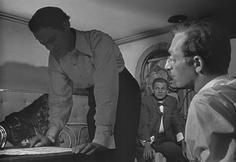
Citizen Kane is an assembly of beautifully arranged scenes, and one of these days I might write about every single one of them. Here is the second entry in my blog from that film – The Declaration of Principles.
It starts with a medium shot on Kane and Jed Leland standing by the window. They appear locked in the window frame in the office of the “Inquirer”. Kane writes the Declaration of Principles facing the window, indicating how important it is to the readers and the people outside.
It starts with a medium shot on Kane and Jed Leland standing by the window. They appear locked in the window frame in the office of the “Inquirer”. Kane writes the Declaration of Principles facing the window, indicating how important it is to the readers and the people outside.
In the next shot the camera rolls inside the office. Kane is in the center of a symmetrical composition between Bernstein and Leland. Leland is on Kane’s right side - a symbolic touch used to emphasize the significant role that Jed plays in their relationship. Later in the film, when Leland is fired, Kane’s entire right side is cut out of the frame; implying that Kane is losing not only a partner, but also his only friend (read about it here).
The dialogue conveys Kane's wish to make his newspaper as essential to the people as gas is to life. Kane is driven by the idea that his paper is the only thing that matters. The next shot poses an intriguing contrast. While talking about the power his medium is about to acquire, he turns off the gas lamp. A dis-association strikes: instead of aspirations to “enlighten” through his newspaper, Kane aims simply to enlarge its circulation and maintain dominance over the reader's mind.
When Kane signs the Declaration his face simultaneously falls into darkness, hiding any facial expression. Shadow separates him from the other two characters who remain well light. Bernstein sits with his back to the camera and the attention is focused on Leland. The cinematographic touch forecasts the developments to come: The promises in the Declaration won’t be kept and the relationship between Kane and Leland will be split apart by conflict.
After Kane signs the Declaration his face becomes well lit as if he is emerging after something dishonest has been done.
Kane’s superiority is emphasized by the low angle of the camera, and by the symmetrical composition of the scene – he is always in the center and standing, while the other two are seated. This is how films should be made - with a thought behind every shot, which contributes to the main idea of the film.
5 / 5
Director: Orson Welles
Starring: Orson Welles, Joseph Cotten, Agnes Moorehead, Everett Sloane
LEARN MORE BELOW
The dialogue conveys Kane's wish to make his newspaper as essential to the people as gas is to life. Kane is driven by the idea that his paper is the only thing that matters. The next shot poses an intriguing contrast. While talking about the power his medium is about to acquire, he turns off the gas lamp. A dis-association strikes: instead of aspirations to “enlighten” through his newspaper, Kane aims simply to enlarge its circulation and maintain dominance over the reader's mind.
When Kane signs the Declaration his face simultaneously falls into darkness, hiding any facial expression. Shadow separates him from the other two characters who remain well light. Bernstein sits with his back to the camera and the attention is focused on Leland. The cinematographic touch forecasts the developments to come: The promises in the Declaration won’t be kept and the relationship between Kane and Leland will be split apart by conflict.
After Kane signs the Declaration his face becomes well lit as if he is emerging after something dishonest has been done.
Kane’s superiority is emphasized by the low angle of the camera, and by the symmetrical composition of the scene – he is always in the center and standing, while the other two are seated. This is how films should be made - with a thought behind every shot, which contributes to the main idea of the film.
5 / 5
Director: Orson Welles
Starring: Orson Welles, Joseph Cotten, Agnes Moorehead, Everett Sloane
LEARN MORE BELOW
 RSS Feed
RSS Feed